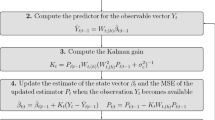Abstract
State space models for tropospheric urban ozone prediction are introduced and compared with linear regression models. The linear and non-linear state space models make accurate short-term predictions of the ozone dynamics. The average prediction error one hour in advance is 7 μg/m3 and increases logarithmically with time until it reaches 26 μg/m3 after 30 days. For a given sequence of solar radiation inputs, predictions converge exponentially with a time scale of 8 hours, so that the model is insensitive to perturbations of more than 150 μg/m3 O3. The slow increase of the prediction error in addition to the uniqueness of the prediction are encouraging for applications of state space models in forecasting ozone levels when coupled with a model that predicts total radiation. Since a radiation prediction model will be more accurate during cloud-free conditions, in addition to the fact that the state space models perform better during the summer months, state space models are suitable for applications in sunny environments.
Similar content being viewed by others
References
Broomhead, D.;G.P. King (1986): Extracting qualitative dynamics from experimental data, Physica D, 20, 217–236
Casdagu, M. (1991): Chaos and deterministic versus stochastic nonlinear modelling, J. R. Statist. Soc. B, 54, 203–328
Casdagli, M. (1992): A dynamical systems approach to modelling input-output systems, In:Casdagu M. andS. Eubank (Eds.): Nonlinear Modeling and Forecasting. Addison-Wesley, MA, pp. 265–281
Casdagli, M.;S. Eubank (1992): Nonlinear Modeling and Forecasting. Addison-Wesley, Reading, MA, USA
Comrie, A.C. (1997): Comparing neural networks and regression models for ozone forecasting, J. Air & Waste Manage. Assoc. 47, 653–663
Fraser, A.M. (1989): Reconstructing attractors from scalar time series: A comparison of a singular system and redundancy criteria, Physica D, 34, 391–404
Gibson, J.F.;J.D. Farmer;M. Casdagu;S. Eubank (1992): An analytic approach to state space reconstruction, Physica D, 57, 1
Levinson, N. (1977): The Wiener RMS (root mean square) error criterion in filter design and prediction, Appendix B In:N. Wiener, Extrapolation, Interpolation, and Smoothing of Stationary Time Series with Engineering Applications. MIT Press, Cambridge, MA
NLO (1990): Lufthygienisches Überwachungssystem Niedersachsen, Jahresbericht 1990. Niedersächsisches Landesamt für Ökologie, Hildesheim, ISSN 0940-1776 edition
NLO (1992): Datenkatalog zur Luftguete in Niedersachsen 1978–1992. Niedersächsisches Landesamt für Ökologie, Hildesheim, ISSN 0945-4187 edition
Preisendorder, R.W.;C.D. Mobley (1988): Principal component analysis in meteorology and oceanography. Elsevier, Amsterdam-New York
Press, W.H.;B.P. Flannery;S.A. Teukolsky;W.V. Vetterling (1992): Numerical recipes: the art of scientific computing. Cambridge University Press, Cambridge, second edition
Spichttnger, N.;M. Winterhalter;P. Fabian (1996): Ozone and Grosswetterlagen — Analysis for the Munich Metropolitan Area, Environ. Sci. Pollut. Res. 3, 145–152
Weigend, A.;N. Gershenfeld (1994): Time Series Prediction. Addison-Wesley, Reading, MA
Author information
Authors and Affiliations
Corresponding author
Rights and permissions
About this article
Cite this article
Vassiliadis, D., Kourtidis, K. & Poulida, O. The potential of statistical state space models in urban ozone forecasting. Environ. Sci. & Pollut. Res. 5, 7–11 (1998). https://doi.org/10.1007/BF02986367
Received:
Accepted:
Issue Date:
DOI: https://doi.org/10.1007/BF02986367




